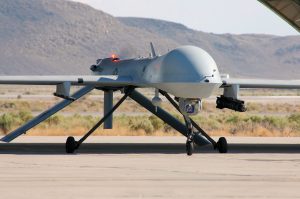The U.S. Department of Defense is making a big bet to counter China: that the employment of thousands of expendable unmanned systems will offset China’s numerical advantages in people, missiles, and ships.
Inspired by the extensive use of such systems in Ukraine, the Pentagon aims to field small and cheap unmanned capabilities within the next 18-24 months as part of the Replicator Initiative. While there are reasons to doubt such a byzantine organization with a long-track record of poor program management could scale up these capabilities in under two years, Replicator might fall short for another reason: The Pentagon is overestimating how decisive drones and other unmanned systems will be in future conflicts.
The war in Ukraine has been a “testbed” for new battlefield technology and operational concepts, drones foremost among them. Drones direct artillery fire, provide persistent overhead surveillance, and target armored vehicles. The Ukrainian military is dedicating significant manpower and resources to maximize their combat effectiveness: Kyiv plans to spend $1 billion to upgrade its drone capabilities and has already trained 10,000 new pilots.
But videos of drones smashing into trenches and chasing tanks across open fields don’t tell the full story. Instead, the war in Ukraine shows that the pursuit of technological offsets only produces fleeting advantages before they are negated by battlefield adaptations.
Since the start of the war, Russia has relied heavily on electronic warfare (EW) to jam, spoof, or destroy Ukrainian drones. Russia’s use of EW isn’t haphazard; it forms a core component of its warfighting doctrine. The Royal United Services Institute (RUSI) reported in May that Russian forces employ one major EW system every 10 kilometers across the front line. Smaller directional jammers are employed at the platoon level while more sophisticated EW systems are used for rear area defense. According to RUSI, Ukrainian forces were losing about 10,000 drones a month due to Russian EW.
Non-technological battlefield adaptations have also undermined the lethality of drones. Rudimentary concealment measures like camouflage or natural foliage are used by both sides to hide vehicles and artillery systems from overhead surveillance. Tunnels have played a role in countering drones: Russian forces reportedly used them to move between their trench lines during Ukraine’s counteroffensive to avoid detection from above. Ukrainian forces even deploy fake howitzers, tanks, and radar systems made from plastic as decoys to trick Russian drone spotters into wasting ammunition. And to further minimize the risk of detection by Russian drones, Ukrainian forces prefer to conduct offensive operations between sundown and sunrise when it is harder for drones to spot infantry movements.
Ad hoc counter-drone innovations have proliferated across the battlefield too. Russian tanks commonly sport metal screens to protect themselves from overhead drone attacks, although smaller and faster first-person view (FPV) drones can still get through. While these adaptations were initially derided as “cope cages,” other militaries have caught on: Israel outfitted its Merkava tanks with metal cages before launching its invasion of Gaza after seeing how effective Ukraine’s drones were against unprotected Russian tanks in the early phase of the war.
Along with the proliferation of effective counter-drone systems and tactics, an overreliance on drones could create new problems for forces in the field. To make Replicator work, the Pentagon is planning on low-level units being able to incorporate drones and other unmanned systems into their operational schemes. Yet there is a risk that an increased tactical reliance on drones could hinder infantry movements. Infantry forces – whose main purpose is to close with and destroy the enemy – must act quickly to seize the initiative. By contrast, drone operators must methodically scan the battlefield for potential threats and targets. And as Ukraine’s drone pilots can attest to, there is also the risk that electromagnetic signals can give away their positions, compromising the tactical advantages of concealment and surprise for the infantry they are supporting.
Notwithstanding both sides’ reliance on unmanned systems, Russian and Ukrainian efforts to counter drones haven’t gone unnoticed in Beijing. China is already moving quickly on the counter-drone front, something Replicator is sure to accelerate.
Vehicle mounted laser defense systems – labeled “drone killers” by the Chinese media – are common sights at Chinese defense trade shows. But the People’s Liberation Army Ground Force is also integrating these capabilities into its tactical air defense units. According to the U.S. Department of Defense’s 2023 report on the Chinese military, PLAGF air defense units are now equipped with a variety of countermeasures, including vehicle mounted air defense guns, small unit electronic warfare systems, and Man-Portable Air Defense Systems (MANPADS).
Drones and other unmanned systems will continue to play a major role in modern warfare, and the Pentagon is right to invest more in cheap, expendable unmanned systems. However, as the Russia-Ukraine conflict shows, battlefield adaptation during a war is more important than the technological advantages each side has at the beginning.

































